Day One
On the parking shuttle, an older couple boarded after I was settled in. She sat across from me, while he sat next to me. Both were wearing Hawaiian shirts, and she was badgering him about his shoe choice. He said he changed his mind this morning because he’d be sitting for 36 hours. I couldn’t let this go, so I asked where in the world they were headed that was a 36-hour flight. He laughed and said he was exaggerating, and that Australia/New Zealand was only a 24-hour flight. They’re going for a month. I’m going to Wisconsin for 9 days. On down the road, she got his attention and nodded at the Leader Dog logo on my shirt. He leaned forward, intuited what her nodding meant, and asked me where to find the best companion dog for his PTSD. So, I’ve got some research to do…
 Day Two
Day Two
Wisconsin is NOT Arizona. There’s more snow in the parking lot of the hotel than I’ve seen collectively in a long time. I’m staying in Menomonee, WI, which is almost halfway between Eau Claire and Roberts, where our two clients on this trip reside. In Eau Claire, snow mounds on both sides of shoveled sidewalks are as tall as I am. Pam has been to Leader Dog for Orientation and Mobility (O&M) before but could really use a refresher at home. We made a plan and headed out. Seven and a half miles later, we came back. I’m so glad I layered up as I needed every layer I had (and wished for a couple more). Pam finished the day by independently crossing a busy, light-controlled intersection that she previously believed she could not cross. The look on her face afterwards was priceless. Kid in a candy store…
Day Three
In Roberts, the sign says “Kinnickinnic,” and we drive to River Falls, WI. I don’t know where I am, but it’s a lovely little town, through which the Kinnickinnic River runs. Busy downtown, good sidewalks, lots of opportunities for good training areas. Abby, my other client, is not as experienced at O&M as Pam, so we started a little slower than yesterday. After she got the basics of cane use down, she really flourished. By the end of the training day, she’d crossed her first street independently. Confidence breeds confidence, so she’s sure to improve even more now.
Day Four
Back in Eau Claire with Pam. Bus travel all day, as she has places to go! Eau Claire has a fairly thorough bus system but needs a few more city employees shoveling snow at some of the bus stops. Really large snow mounds to cross between the stop and the street. We had one regular bus rider promise to shovel around “his” stop before we come back on Friday. (I know the city is working hard, and there’s a TON of snow about. No serious complaints here.) Public transportation is always full of interesting and unique personalities. I like to think Pam and I added to that today 😊
Day 5
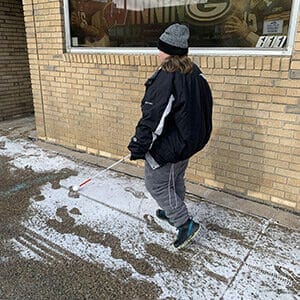 Back in River Falls/Roberts/Kinnickinnic. Wherever I was, it was rainy and cold. They’ve predicted more snow starting any time, but I haven’t seen a flake yet. Not falling from the sky, at least. We did a bity of sightseeing first, walking over a suspension bridge over the river that’s been here for a long time. Very groovy. It swings when you walk across. NOT groovy.
Back in River Falls/Roberts/Kinnickinnic. Wherever I was, it was rainy and cold. They’ve predicted more snow starting any time, but I haven’t seen a flake yet. Not falling from the sky, at least. We did a bity of sightseeing first, walking over a suspension bridge over the river that’s been here for a long time. Very groovy. It swings when you walk across. NOT groovy.
Abby is getting really confident. She crossed several busy, light-controlled intersections independently today. She had a great smile on her face after each one.
Day 6
St. Patrick’s Day. Everyone’s Irish today, right? I actually am, at least a percentage of me is, and I treated myself as such. Corned beef, cabbage, potatoes and Irish soda bread in celebration… maybe a dark, heady lager or two after work.
Oh, I did teach mobility today, and Pam did great. Also, it’s still cold in Wisconsin…
Day 7
Back in River Falls, back to working on purposeful routes for Abby. As a plus today, it’s windy AND numbingly cold. Woo hoo! Introduced stair technique to Abby and she did really well. She sure feels a lot better about the technique than before. We’re working on a route to the grocery store where she does most of her shopping. So far, she’s been able to travel the three block route to the store and back. I’ve been helping her less and less each time. The way I see it, it’s my job to work myself out of a job, so I must be getting good at this 😊 Also, Abby says I’m a good coach. I like the sound of that!
Day 8
Last day in River Falls, working on that route to the grocery store. I didn’t say a word to her the whole time, until she got there. She was so proud of herself, as she should have been. She had a couple of foibles on the way back, but she’s really getting it. The benefit of this program is consistency and the ability to do it over and over again. You really get to see a lot of progress over a short period of time. When I dropped her off at her house at the end of the day, she said, “Thanks, Coach.”
Day 9
Last day in Eau Claire. More bus routes. Having a working knowledge of the bus system is really going to open up Pam’s ability to travel independently within Eau Claire and the surrounding communities. She’s really making an effort to get to know the drivers, which is a really good strategy because the more they know you, the more likely they are to help you out if you need a hand.
I went to dinner with Pam and her husband at the end of the day and had to absolute biggest cheese curds I’ve ever seen! Big, and delicious. They really know how to eat in Wisconsin!
Message from Pam
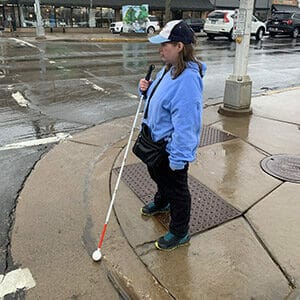 After Barry returned home, Pam wrote on Facebook about her experience working with him for in-home Orientation and Mobility.
After Barry returned home, Pam wrote on Facebook about her experience working with him for in-home Orientation and Mobility.
“I have finished my second series of O&M training. I was very fortunate to have Barry come to my city and help train me in my own surroundings, and how to cross a very busy intersection and also how to use the bus system. For me, this is a huge life changer in and of itself. I live in a perfect location that I can walk to stores and restaurants. However, as my vision continues to get worse, and I have periods of time when I can’t see at all, this added defining skill continues to allow me to be independent. Leader Dog changes our lives in so many ways. Developing this program where an instructor can come to you and train you in your environment is truly life-saving. I feel if this type of opportunity were available for more people, it would keep more of us being able to manage our own lives in our own time frames on our own. I am hoping as I fine-tune the skills and as my vision continues to decline that I will qualify for a Guide Dog. She would truly help me to get out every day, which I usually do anyway. And add a joy to my life that can compare to nothing else. Barry came to northern Wisconsin where I live from Texas where he lives. So snow and cold is not something that he deals with every day. He had the most positive, supportive attitude. He was encouraging. Leader Dog has the most incredible staff I have ever worked with in my life. I am a retired registered nurse and have worked many different jobs in many different settings. And I know how supportive and kind one person is to another can change all life. And Leader Dog does that every day. God bless you for being there.”
About Barry and his work
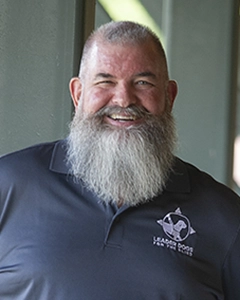
The home delivery option for orientation and mobility is a new one at Leader Dog since June 2022. It’s an option we’ve always thought would be a good idea with our clients, either serving directly in their homes at the onset, or following them home to help them establish routes, putting into practice what they’ve learned over the course of their training on campus. It has proven to be very effective. Serving clients who may not be able to travel for myriad reasons such as health issues, single parent responsibilities, or a desire to work on very specific public transportation routes or intersections are some of the main reasons home delivery we offer home delivery. When home delivery occurs, the client receives the same amount of O&M training as if they were at Leader Dog. Plus, they get the benefit of doing it in their home environment. There are benefits and drawbacks to each method of training, but by adding the home delivery option, we’ve given our clients more flexibility.
My name is Barry Stafford and I work at Leader Dog as a certified orientation and mobility specialist providing both on-campus and home delivery instruction. I’ll be sharing some of my stories with you as I travel the U.S. to work with clients and provide home delivery service of O&M instruction.

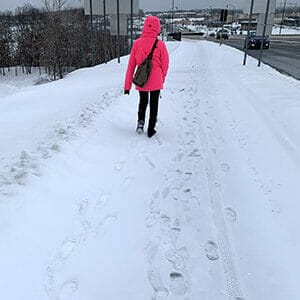 Day Two
Day Two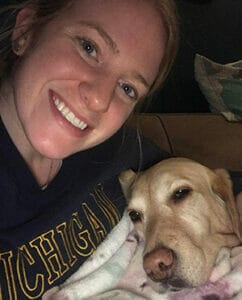
 Just before the pandemic, my now husband and I got our first dog, Milo, an Australian cattle dog mix. Milo is a working breed, and he impresses me every day with his energy, his willingness to learn, and his big brain. It wasn’t until we got Milo that I truly realized the profound impact that being a dog owner can have on someone. Our dog’s ability to pick up on our emotions and to bring so much joy into our lives never ceases to amaze me! We adopted another dog, Daisy (beagle mix!), in 2022 and our lives were changed for the better once again.
Just before the pandemic, my now husband and I got our first dog, Milo, an Australian cattle dog mix. Milo is a working breed, and he impresses me every day with his energy, his willingness to learn, and his big brain. It wasn’t until we got Milo that I truly realized the profound impact that being a dog owner can have on someone. Our dog’s ability to pick up on our emotions and to bring so much joy into our lives never ceases to amaze me! We adopted another dog, Daisy (beagle mix!), in 2022 and our lives were changed for the better once again. I now volunteer with the breeding dogs, and I absolutely love it. I feel so honored to play even a small role in the journey to get clients the guide dogs that they need. I love all the dogs—the playful ones, the chill ones, the excited ones, the slobbery ones, and the adorable ones (okay, they’re all adorable). I usually only spend time with the older dogs, but recently got to help feed the Future Leader Dog puppies on my shift—what a highlight!
I now volunteer with the breeding dogs, and I absolutely love it. I feel so honored to play even a small role in the journey to get clients the guide dogs that they need. I love all the dogs—the playful ones, the chill ones, the excited ones, the slobbery ones, and the adorable ones (okay, they’re all adorable). I usually only spend time with the older dogs, but recently got to help feed the Future Leader Dog puppies on my shift—what a highlight!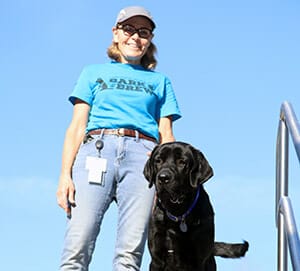
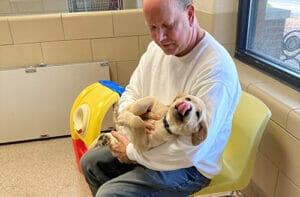 Leader Dog volunteers actively, joyfully and with purpose participate in every aspect of our operations. At times, some of the work is messy, smelly or repetitive, but volunteers never shy away. They roll up their sleeves and get the job done. When asked to take on a new role or help solve a new challenge, they always step up. Leader Dogs for the Blind volunteers are a special “breed” indeed.
Leader Dog volunteers actively, joyfully and with purpose participate in every aspect of our operations. At times, some of the work is messy, smelly or repetitive, but volunteers never shy away. They roll up their sleeves and get the job done. When asked to take on a new role or help solve a new challenge, they always step up. Leader Dogs for the Blind volunteers are a special “breed” indeed.
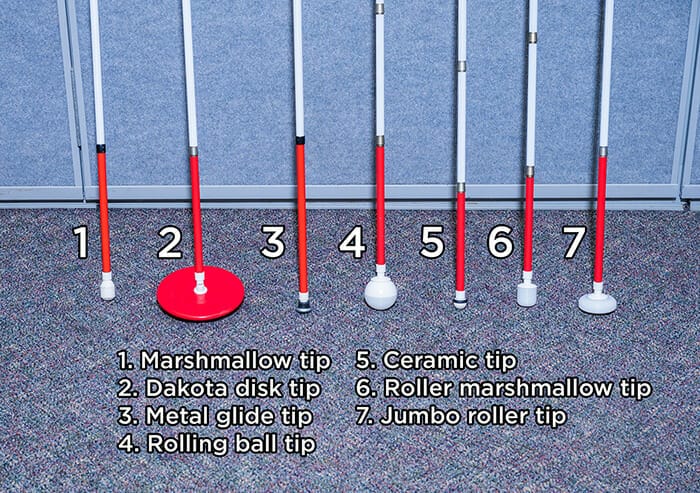
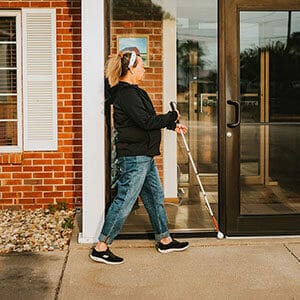 There are numerous cane manufacturers, but I want to focus on two big brands in the cane world: NFB (National Federation of the Blind) and Ambutech. NFB are primarily known for being one type, which are long rigid canes that are extremely light and flexible. They typically come with one tip option, the metal glide tip, which is fixed in place. Ambutech makes and sells many different types of canes. They tend to be a little heavier than NFB canes, but they make up for it with versatility. Many Ambutech canes have a bungee cord that goes through the center of the cane, this lets the cane have interchangeable cane tips. Ambutech canes come in both rigid (one solid piece) or folding.
There are numerous cane manufacturers, but I want to focus on two big brands in the cane world: NFB (National Federation of the Blind) and Ambutech. NFB are primarily known for being one type, which are long rigid canes that are extremely light and flexible. They typically come with one tip option, the metal glide tip, which is fixed in place. Ambutech makes and sells many different types of canes. They tend to be a little heavier than NFB canes, but they make up for it with versatility. Many Ambutech canes have a bungee cord that goes through the center of the cane, this lets the cane have interchangeable cane tips. Ambutech canes come in both rigid (one solid piece) or folding.
 I woke up reminding myself where I was. Sometimes, the rooms can start to look the same. The free, hot breakfast included bacon. Boom. I also had to remind myself what car I’m driving this week. The “panic” button works great when you don’t know which one is yours, but it tends to make other folks a little nervous. I’m staying in Mesa, and my client is in Scottsdale, so I left a little early to scout out the neighborhood. Google Maps gives me a good idea about each client’s home area, but nothing beats walking the area myself.
I woke up reminding myself where I was. Sometimes, the rooms can start to look the same. The free, hot breakfast included bacon. Boom. I also had to remind myself what car I’m driving this week. The “panic” button works great when you don’t know which one is yours, but it tends to make other folks a little nervous. I’m staying in Mesa, and my client is in Scottsdale, so I left a little early to scout out the neighborhood. Google Maps gives me a good idea about each client’s home area, but nothing beats walking the area myself.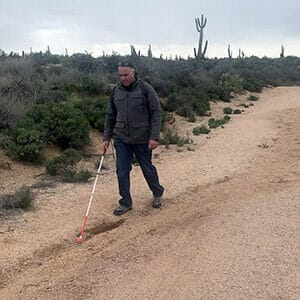 We spent today hiking the Sonoran Desert today. Colin is an avid hiker, mountain biker, skier, etc. but hasn’t done much since his latest vision decline. I mentioned going hiking with the client I worked with last month, and he said, “Can we do that?” 100%! I feel like part, or most, of my job is to increase people’s confidence to the point that they can do the things they want to do, when they want to do them. So, he packed his hiking pack, planned a route and we went hiking. Colin used his cane for a while. He’s using a roller ball tip, which works pretty well on harder surfaces, and it really helped him find sharp drop-offs in the path. The ball tip is not great on deep, sandy material, nor is it good for technical hiking where you might need some support in steep climbs. He has a trekking pole that worked really well in those situations, but it didn’t give him a lot of preview. So, we tested out both in as many different situations as we could and decided that we needed to develop our own hiking cane. One that’s strong enough to lean on and use for support, but with a tip that won’t roll out from under you when you do, among other qualities. We’ll let you all know what we come up with.
We spent today hiking the Sonoran Desert today. Colin is an avid hiker, mountain biker, skier, etc. but hasn’t done much since his latest vision decline. I mentioned going hiking with the client I worked with last month, and he said, “Can we do that?” 100%! I feel like part, or most, of my job is to increase people’s confidence to the point that they can do the things they want to do, when they want to do them. So, he packed his hiking pack, planned a route and we went hiking. Colin used his cane for a while. He’s using a roller ball tip, which works pretty well on harder surfaces, and it really helped him find sharp drop-offs in the path. The ball tip is not great on deep, sandy material, nor is it good for technical hiking where you might need some support in steep climbs. He has a trekking pole that worked really well in those situations, but it didn’t give him a lot of preview. So, we tested out both in as many different situations as we could and decided that we needed to develop our own hiking cane. One that’s strong enough to lean on and use for support, but with a tip that won’t roll out from under you when you do, among other qualities. We’ll let you all know what we come up with.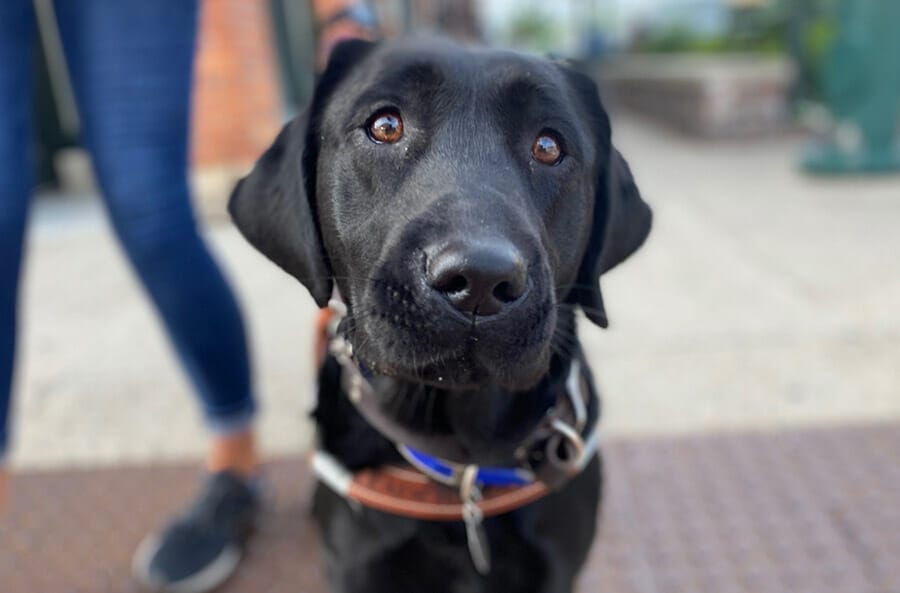
 Myth #2: Guide dogs are always “on duty.” Truth: Guide dogs are definitely trained to work when they’re in harness with their handlers, but they also need time to relax and play. When they’re not working, Leader Dogs are just dogs—running around, playing and snuggling with their people.
Myth #2: Guide dogs are always “on duty.” Truth: Guide dogs are definitely trained to work when they’re in harness with their handlers, but they also need time to relax and play. When they’re not working, Leader Dogs are just dogs—running around, playing and snuggling with their people.